|
Quilt History
Today's Quilt Historians
Underground Railroad
Women at Work
|
|
New Pathways into Quilt History written by Kimberly Wulfert,
www.antiquequiltdating.com
Treadle Sewing Machines:
The
Non-Electric Sewing Machine,
People Powered Sewing Machines, Not Just for the Amish
by Anne Kusilek |
|
Quilting
Through
Time
... new online store.
Shop my
new store
for ... Quilt Textile
History Books, Ephemera,
Stationery, DvDs, Threads, Battings, Uncommon
Gifts
Quilters Will Love
|
Anne is a sewing machine collector and
professional quilter from Prairie Farm, WI has been using people-powered sewing
machines for 16 years. Known by sewing machine collectors as “Damascus Annie”,
she is considered an authority on machines made by the National Sewing Machine
Company and her collection of over 40 sewing machines is one of the largest
collections of Nationals in the country.
In 1990, my husband bought me my first treadle sewing machine for a Mother’s Day
gift. It was (and is) a beautiful “Damascus Grand” Rotary machine made in the
early 1920’s for Montgomery Wards by the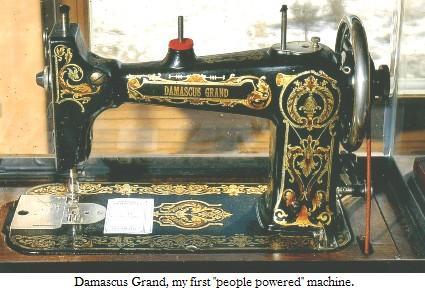 National Sewing Machine Company of Belvidere, IL. We thought it would look
pretty in our restored bungalow’s living room. I had no way of knowing that this
machine would revolutionize the way I sew. We threaded it up on a whim, just to
see if it still worked and I’ve never really looked back.
National Sewing Machine Company of Belvidere, IL. We thought it would look
pretty in our restored bungalow’s living room. I had no way of knowing that this
machine would revolutionize the way I sew. We threaded it up on a whim, just to
see if it still worked and I’ve never really looked back.
“People-powered” machines (PPMs for short) take two basic forms: the familiar
treadle machine with its foot pedal mounted in a free-standing cabinet, and the
handcrank.
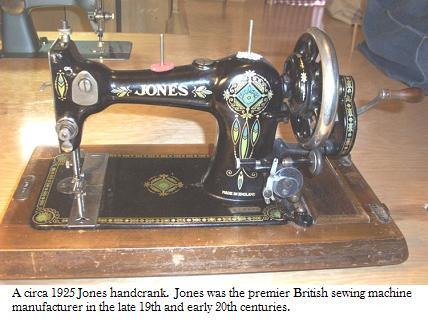 Early
machines were almost exclusively handcrank versions, although an early French
machine did feature a treadle mechanism. Early
machines were almost exclusively handcrank versions, although an early French
machine did feature a treadle mechanism.
Most people would agree that treadle machines are the most convenient to use as
they allow the sewist to use both hands to manipulate the fabric and in my
quilting studio I use treadle machines for 99% of my sewing. My customized
treadle table has five machines mounted in it: three machines that were
originally treadles and two that were electrics.
Many electric machines work well as treadles for the simple reason that a
machine doesn’t know the origin of its power source. In theory, any belt driven
sewing machine can be powered by either a handcrank, a treadle, or a motor. The
only time electricity is essential is when your machine is computerized or has a
dire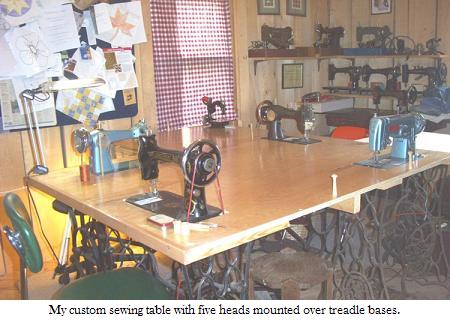 ct
gear linkage to the motor as opposed to a belt. By the 1920s most sewing
machines were offered as treadles, handcranks or electrics and Singer’s model 15
was offered as a handcrank, as a treadle, as a belt-driven electric and as a
direct-drive electric. ct
gear linkage to the motor as opposed to a belt. By the 1920s most sewing
machines were offered as treadles, handcranks or electrics and Singer’s model 15
was offered as a handcrank, as a treadle, as a belt-driven electric and as a
direct-drive electric.
My five main machines are good examples of the versatility available to the
non-electric seamstress. I use a 1950s Japanese-made “B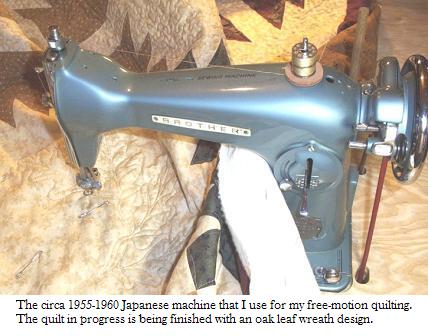 rother,”
a clone of the popular Singer 15, for my machine quilting business--I don’t have
a long-arm quilting machine. rother,”
a clone of the popular Singer 15, for my machine quilting business--I don’t have
a long-arm quilting machine.
These inexpensive electric machines flooded the U.S. market after World War II
largely because the U.S. government gave our sewing machine technology to the
Japanese as part of the Marshall plan. While they are usually sneered at by
sewing machine collectors for being too “new” and common, they are an excellent
choice if you are looking for a strong, durable, straight-stitch machine.
I’ve tried several different vintage models for free-motion quilting and in my
opinion the 15 class machines are far and away the best choice for two reasons:
the bobbin arrangement and droppable feed dogs. The vertical bobbin arrangement
allows the thread to feed directly up to the needle greatly reducing strain and
wear on the bobbin thread. Dropping the feed dogs reduces resistance as the
quilt is moved under the needle, although it’s not absolutely necessary. I often
demonstrate free-motion quilting with the dogs up just to prove that it can be
done.
The vintage 15 class machines are built more heavily than most modern machines
and are able to punch through the layers of a quilt without difficulty. Because
they have steel internal parts and only one stitch option they almost never wear
out if kept cleaned and oiled. Another advantage is that they take common modern
needles, bobbins, and quilting feet. I use a vintage Elna darning foot on mine,
but most low-shank darning feet will work on it.
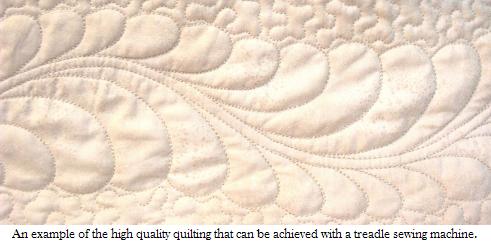
 I
also have a formerly electric Japanese “Sew-Mor” 15 class zig-zagger from the
late 50’s or early 60s. This machine is used for patching, machine applique,
finishing seams on fabrics that fray easily, and zig-zag free-motion quilting.
It is a high-shank model and I use a plastic high-shank darning foot on it that
I purchased at my local quilt store. Like my quilting head, it is all-metal
inside and out and is as strong as an ox, punching through 5 or 6 layers of
denim without a problem. I
also have a formerly electric Japanese “Sew-Mor” 15 class zig-zagger from the
late 50’s or early 60s. This machine is used for patching, machine applique,
finishing seams on fabrics that fray easily, and zig-zag free-motion quilting.
It is a high-shank model and I use a plastic high-shank darning foot on it that
I purchased at my local quilt store. Like my quilting head, it is all-metal
inside and out and is as strong as an ox, punching through 5 or 6 layers of
denim without a problem.
My primary piecing machine is a 1920s National Two Spool , probably one of the
most interesting sewing machines ever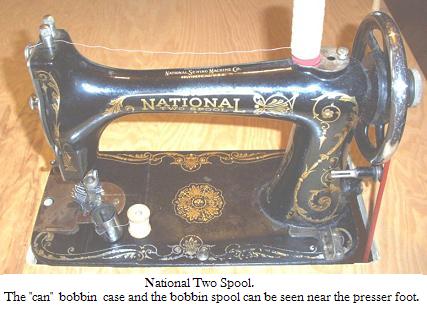 made. The name derives from the unique bobbin: a second spool of thread that
pops into a “can” bobbin case. With this wonderful machine, I can piece for 8-10
hours without winding a bobbin! If I could find a darning foot for it, it would
definitely become my free-motion quilting head. Unfortunately, the presser foot
clamping system is obsolete and darning feet are not made for them. Oddly
enough, there didn’t seem to be a high demand for these machines so they are a
bit hard to find but well worth the search if you sew a lot.
made. The name derives from the unique bobbin: a second spool of thread that
pops into a “can” bobbin case. With this wonderful machine, I can piece for 8-10
hours without winding a bobbin! If I could find a darning foot for it, it would
definitely become my free-motion quilting head. Unfortunately, the presser foot
clamping system is obsolete and darning feet are not made for them. Oddly
enough, there didn’t seem to be a high demand for these machines so they are a
bit hard to find but well worth the search if you sew a lot.
For straight line (grid) quilting, applying bindings and working with flannels
or other fabrics that want to shift under the presser foot, I have a ca. 1910
Davis Vertical Feed
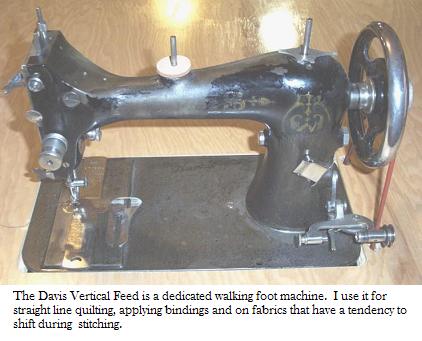 .
Like the Two Spool, this machine is an oddity: it’s a walking foot machine
without feed dogs. I acquired mine from a neighbor who was going to throw it
away due to serious finish problems on the head. I removed most of the finish
down to the base metal, keep it wiped down with sewing machine oil so it won’t
rust, and use it that way. It’s not pretty but now that I have it, I wouldn’t be
without it. I’ve used walking foot attachments, but none of them ever came close
to working as well as this old machine. Like most antique machines, it can
handle almost anything you throw at it and doesn’t quibble when I’m sewing
through 6 lay .
Like the Two Spool, this machine is an oddity: it’s a walking foot machine
without feed dogs. I acquired mine from a neighbor who was going to throw it
away due to serious finish problems on the head. I removed most of the finish
down to the base metal, keep it wiped down with sewing machine oil so it won’t
rust, and use it that way. It’s not pretty but now that I have it, I wouldn’t be
without it. I’ve used walking foot attachments, but none of them ever came close
to working as well as this old machine. Like most antique machines, it can
handle almost anything you throw at it and doesn’t quibble when I’m sewing
through 6 lay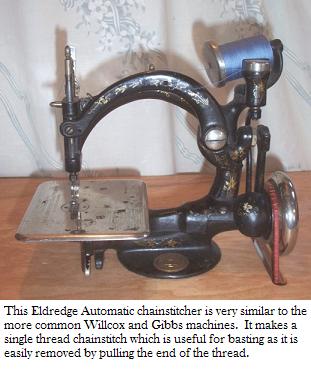 ers of fabric plus batting to attach a binding. ers of fabric plus batting to attach a binding.
The last machine mounted in my treadle table, is a National Chainstitcher--basically
a copy of the more common Willcox and Gibbs chainstitcher Often mistaken for
toys by the uninitiated, these are full-sized working sewing machines that make
a one-thread chain stitch (no bobbin). However, the stitch has a flaw: if it
breaks or isn’t fastened off correctly at the end, the whole thing zips out!
This “drawback” makes it the perfect machine for temporary jobs like theatrical
alterations, clothing fittings, and other jobs requiring basting. I use mine to
baste temporary strips to protect the edges of quilt tops prior to hand quilting
or applique (which I do in a hoop) and for simple machine embroidery.
To see Anne’s sewing machines and examples of her work go to:
http://community.webshots.com/user/damascusannie
Bio and contact info:
Her quilting business, “Finely Finished,” caters to clients who want a unique
custom finish for their quilts. Many (but not all) of her clients use treadle or handcrank sewing machines to piece their tops and wish to have their quilts
finished by treadle as well. Anne says, “I love my job. Every top has a story
and was a labor of love for the maker. It’s a joy to bring these beautiful tops
to life as a quilts.”
Anne demonstrates regularly at quilt shows, museums and re-enactment events
where she dresses in reproduction period costumes ranging from the Civil War to
the 1950s, depending on the event and her mood.
She comments, “I get a real kick from the reactions of quilters as they watch me
free-motion quilt on a treadle sewing machine. Someone always asks me if I’m
crazy, especially when they find out that I do ALL of my sewing this way.”
Anne also sets up and sells handcrank machines. Most of her machines are sold to
parents and grandparents looking for safe, reliable, easy-to-use machines for
children.
You may contact her by e-mail at:
toomanydogs@chibardun.net or call her at:
715-455-1911 for more information about sewing machines or quilting.
For more sewing machine history, see my article:
The Sewing Machine and
Quilters in the 19th Century |
*
Women (and Men) at Work
© 2005 - 2022 Kimberly Wulfert, PhD. Absolutely no copies, reprints, use
of photos or text are permitted for commercial or online use. One personal copy for study purposes is permitted.
|
Fabrics & Dyes
Rugs & Textiles
Books & Reviews
Resource Links
Home
|